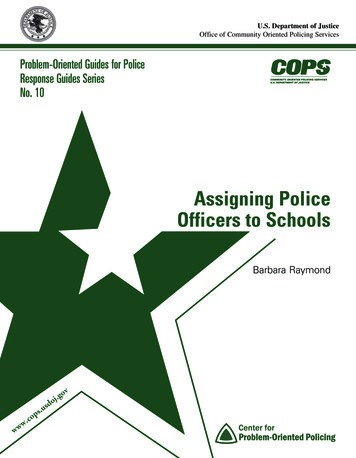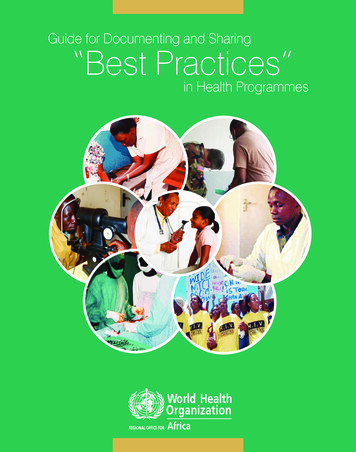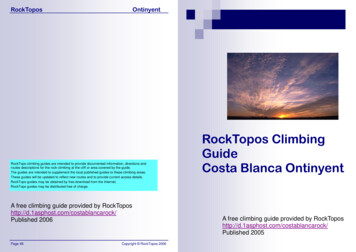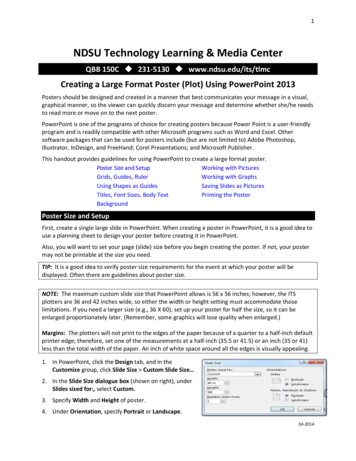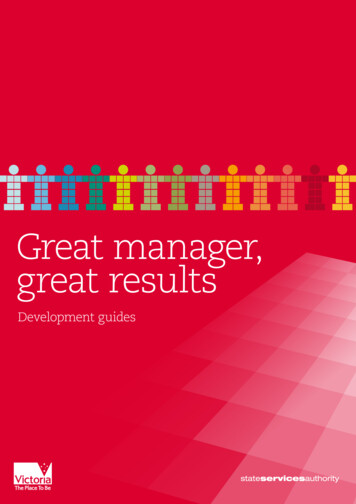
Transcription
HealthCommunicationsin Tobacco Prevention and Control
AcknowledgementsThis guide was produced for the Centers for Disease Control and Prevention by the Center for PublicHealth Systems Science at the Brown School at Washington University in St. Louis.Primary contributors:Stephanie Andersen, Laura Brossart, Isaiah Zoschke, Caitlin Ashby, Erin Foster, Rachel Barth, Sarah MorelandRussell, Douglas LukeInput was provided by:Brian Armour, Caryn Coln, Gail DeVito, Cecile Douglas, Monica Eischen, Randy Gibson, Karen Gutierrez, RobinHobart, Michelle Johns, Elizabeth Kilgore, Brian King, Chris Kissler, Julie Lautsch, Sjonna Paulson, Tim Poor, GabbiPromoff, Valerie Quinn, Robert Rodes, Amy Rowland, Robin Scala, Maggie Silver, Karla Sneegas, Ann Staples,Renee WrightInput for the case studies was provided by:Ann Staples, North Carolina Tobacco Prevention and Control BranchGregg Smith, Bureau of Tobacco Free FloridaLacoadia Burkes, Bureau of Tobacco Free FloridaIan Abrams, GolinNaylet Aguayo, GolinElizabeth McCarthy, Alma DDBOther contributions:Photograph on page 7 courtesy of the U.S. Food & Drug AdministrationPhotographs on page 19 and 31 courtesy of the New York City Department of Health and Mental HygienePhotograph on page 20 courtesy of the Oklahoma Tobacco Settlement Endowment TrustPhotograph on page 26 courtesy of the California Department of Public HealthPhotograph on page 27 courtesy of the Rhode Island Department of HealthPhotograph on page 52 courtesy of Tobacco Free Florida
Table of ContentsGuide to the Reader 1Making the Case 2Brief History 3How to 4What are Health Communications in Tobacco Prevention and Control? 4Importance of Health Communications 5Types of Health Communications 6Implementing Health Communications Strategies 13Developing a Communications Plan 13Researching the Intended Audience 17Developing Effective Messages 19Using a Mix of Strategies 22Preparing to Launch a Campaign 24Developing and Placing Paid Media 25Generating Earned Media 32Sharing Messages on Social Media 37Developing Program Communications 42Reducing Tobacco-Related Disparities 45Making Adjustments and Responding to Problems 47Evaluating Health Communications 48Providing Support 51Case Studies 54Case for Investment 56Resources 58References 62
GUIDE TO THE READERPurposeThe Centers for Disease Control and Prevention’s(CDC) Office on Smoking and Health and the Centerfor Public Health Systems Science at WashingtonUniversity in St. Louis are developing a set of userguides funded by the CDC (contract 200-2015-87568)for the Best Practices for Comprehensive TobaccoControl Programs—2014 (Best Practices 2014).1The purpose of the user guides is to help tobaccocontrol staff and partners implement evidence-basedbest practices by translating research into practicalguidance. The user guides focus on strategies (e.g.,programs and interventions) that have shown strong orpromising evidence of effectiveness. Recommendationsin this guide are suggestions for programsimplementing health communications strategies.Programs can follow these recommendations accordingto their needs, goals, and capacity.ContentThis user guide focuses on how comprehensivetobacco control programs can deliver effective healthcommunications. Best Practices 2014 recommendsmass-reach health communication interventionsas “powerful tools for preventing the initiation oftobacco use, promoting and facilitating cessation, andshaping social norms related to tobacco use.”1 Healthcommunications help achieve tobacco control goalsby building support for policy and program efforts,countering the tobacco industry’s extensive advertisingand promotion, and reaching large audiences to shiftsocial norms around tobacco use. This guide offersprogram staff and partners information on howto effectively develop and implement paid media,earned media, social media, and other programcommunications to support tobacco control efforts.Links to More InformationOrganization88 Making the Case: A brief overview of why healthcommunications are an essential part of tobaccocontrol efforts88 Brief History: How health communications havebeen used in tobacco prevention and control88 How to: Strategies to plan and carry out healthcommunications efforts88 Providing Support: How tobacco controlprograms can support staff and partners’ healthcommunications efforts88 Case Studies: Real-world examples of healthcommunications in tobacco prevention and control88 Case for Investment: Information to gainsupport for health communications88 Resources: Publications, toolkits, and websites tohelp in planning effortsBest Practices for ComprehensiveTobacco Control Programs—20141Best Practices 2014 is an evidencebased guide to help states plan, establish,and evaluate comprehensive tobaccocontrol programs. The report offersrecommendations and supporting evidencefor five essential components of effectivetobacco control programs: state andcommunity interventions, mass-reachhealth communication interventions,cessation interventions, surveillanceand evaluation, and infrastructure,administration, and management.Each instance of italicized, bolded blue text in the guideindicates a link to an additional resource or a pagewithin the guide itself with more information. Websiteaddresses for all of the blue resources noted throughoutthe guide are also included in the Resources section.Health Communications l 1
MAKING THE CASEMaking the Case for Health CommunicationsHealth communications in tobacco control can empower both individuals to change their behavior andcommunities to adopt policies that reduce tobacco use, prevent initiation, and limit exposure to secondhandsmoke.2 Health communications are an essential part of a comprehensive tobacco control program because they:88 Reduce tobacco use and secondhand smokeexposureMass-reach communications reduce tobaccouse among youth and adults,3,4,5,6,7,8 increase quitattempts,6,8 increase use of cessation services,1,4,5,7 andprevent youth initiation.1,4,5 They can also reduce thelikelihood of relapse among people who quit.988 Counter the industry’s extensive advertising andpromotion effortsThe tobacco industry spends over 1 million perhour to advertise and promote tobacco products.10Health communications can counter industryadvertising with messages about the healthconsequences of tobacco use. As the industryfinds innovative ways to promote its products, theimportance of effective health communications intobacco control continues to increase.188 Support tobacco control policy and programeffortsHealth communications build public support forstrong tobacco control policies and programs byeducating the public and decision makers aboutthe importance of reducing tobacco-relateddisease and death.5,11Health Communications l 288 Shift social norms around tobacco useHealth communications efforts can reach largeaudiences through media channels like TV andradio.12 As a result, communications efforts caninfluence social norms around tobacco use.1,1188 Reduce tobacco-related disparitiesHealth communications efforts can reducetobacco-related disparities among diversegroups.1,2 Communications about the negativehealth consequences of tobacco can reach and beinfluential among populations of different ages,education levels, incomes, races, ethnicities, sexes,sexual orientations, or gender identities.1,788 Create a return on investmentHealth communications efforts can save lives andbillions of dollars in health care costs.4,13 From 2000to 2002, the national truth campaign cost 324million and saved over 1.9 billion in health carecosts.14 In 2012, the Tips From Former Smokers national tobacco education campaign cost 48million and prompted 100,000 smokers to quit forgood, which is estimated to have prevented over17,000 premature deaths.15
BRIEF HISTORYBrief HistoryHealth communications were one of the earliestapproaches to reduce tobacco use and secondhandsmoke exposure. The first U.S. tobacco controlcommunications campaign aired on TV in 1967(see Figure 1 below).3 The campaign followed theFederal Communications Commission’s decision toapply the Fairness Doctrine to cigarette advertising,which required TV stations to devote free airtime toopposing views on topics of public interest. Cigaretteads were banned from TV and radio in 1971, endingfree broadcast time for tobacco control messages.3Cigarette consumption decreased during the time thatthe ads were on the air, but began to rise again after themessages concluded.16The success of early tobacco control ads prompted morecampaigns, including the first statewide campaignin Minnesota in 1986.5 Campaigns in California,Massachusetts, and Florida soon followed. They focusedon changing social norms about secondhand smoke,educating the public about the health consequences ofsmoking, and revealing the tobacco industry’s deceptivemarketing tactics.3 These campaigns successfullyreduced smoking prevalence and served as a model forother campaigns.6,17 Between 1998 and 2002, at least 30other states began communications campaigns.8 In 2000,the American Legacy Foundation (now Truth Initiative)expanded Florida’s truth campaign nationwide.18 TheFoundation launched the national EX campaign in 2008,which focused on lower income smokers from diverseracial and ethnic backgrounds.19As communications campaigns increased, evidenceof their effectiveness began to emerge. As early as1994, the Surgeon General’s Report, Youth & Tobacco,recommended health communications to reduce youthtobacco use.20 In 2008, the National Cancer Institute’sMonograph 19 concluded that campaigns reduce adulttobacco use and prevent youth initiation.5 The 2012Surgeon General’s Report, Preventing Tobacco UseAmong Youth and Young Adults, added that greaterexposure to ads further reduces youth smoking.3 The2014 Surgeon General’s Report, The Health Consequencesof Smoking—50 Years of Progress, concluded thatcampaigns with sufficient reach, frequency, and durationcan be powerful tools to reduce tobacco use.11 Healthcommunications are also included in the World HealthOrganization’s Framework Convention on Tobacco Controland Healthy People 2020, a set of national objectives forhealth promotion and disease prevention.21,22Health communications have expanded in recent yearsas programs increasingly use websites and social mediato complement traditional strategies. In 2012, CDClaunched its first national tobacco education campaign,Tips From Former Smokers . The campaign features“tips” from adult former smokers about living withtobacco-related disabilities and diseases as motivationto help smokers quit. It integrates digital ads, socialmedia, and a website with traditional channels.23During the 2012 campaign, 200,000 people called theQuitline, 500,000 people visited Smokefree.gov, and 1.6million smokers made a quit attempt.24 Since 2014, theU.S. Food & Drug Administration (FDA) has launchedseveral youth-focused campaigns, including The RealCost and Fresh Empire.25,26 Both campaigns use a mix oftraditional and digital channels.Figure 1. History of Tobacco Control CommunicationsHealth Communications l 3
HOW TOWhat are HealthCommunications inTobacco Prevention andControl?Health communications is “the study and use ofcommunications strategies to inform and influenceindividual and community decisions related tohealth.”27 In tobacco control, health communicationsempower individuals to change behaviors andencourage states and communities to adopt policiesthat reduce tobacco use, prevent initiation, and limitexposure to secondhand smoke.2 They are sometimesreferred to as “countermarketing” because they tryto counteract the marketing practices of the tobaccoindustry.1 Health communications can be deliveredthrough several strategies: Paid media strategies (paying to place ads on TV,radio, billboards, transit, online platforms, or inprint media) Earned media strategies (generating free coveragein the press and through public serviceannouncements) Social media strategies (sharing messages andengaging audiences on social networking siteslike Facebook and Twitter) Program communications (delivering messagesthrough program websites and stakeholdercommunications)Other activities, like promoting the quitline andreducing or replacing tobacco industry sponsorshipand promotions, are also important parts of a program’scommunications effort.1 The combination of thesestrategies to communicate about a specific issue is oftenreferred to as a communications campaign. The exactmix of strategies varies for each campaign. If sufficientfunds are available, mass-reach communicationschannels such as TV are important to make meaningfulpopulation-level changes.28Health Communications l 4CDC’s “Tips ” campaign ad created for paid media channels like magazines andnewspapers Source: CDC MCRCCommunications campaigns may be brief or run forlong periods of time. They may focus on reachingtobacco users, their families, specific populations,health care providers, the media, or decision makers.Campaigns are most effective when they are integratedinto the larger program.1,5 For example, campaigns mayinclude the quitline number or raise awareness about anew tobacco control policy.Tobacco control communications often focus on thefollowing messages:1 Motivating tobacco users to quit Changing social norms to prevent tobacco useinitiationProtecting people from the harms ofsecondhand smoke exposure
HOW TOImportance of Health CommunicationsHealth communications are a critical part ofcomprehensive tobacco control programs. Effectivehealth communications can raise awareness about thedangers of tobacco use,29 increase community supportfor tobacco control programs and policies,11 andreduce tobacco use.3,4 Health communications are alsoimportant to counter tobacco industry advertising andpromotion, especially as the industry increasingly usesnew advertising tactics to market products.Effectiveness of Health CommunicationsThe Community Guide recommends mass-reach healthcommunication interventions based on strong evidenceof effectiveness.4 These strategies can reach largeaudiences quickly, repeatedly, and cost effectively.4,12As a result, they can shift social norms around tobaccouse and increase acceptance of tobacco prevention andcontrol strategies.1,11 Mass-reach health communicationinterventions reduce tobacco use among youth andadults,3,4,5,6,7,8 increase quit attempts,6,8 increase use ofcessation services,1,4,5,7 prevent youth initiation,1,4,5 andCommunications Campaigns asTobacco Control InterventionsHealth communications campaigns are animportant part of comprehensive tobaccocontrol programs. They can: Change how people think abouttobacco use and secondhandsmoke27,29Counter the effects of industryadvertising and promotion30Result in simple actions like callingthe quitline or talking to a health careprovider about tobacco use27,29Build support for tobacco control4,11Prevent youth initiation1,4Motivate tobacco users to quit1,4reduce the likelihood of relapse among people whoquit.9 Health communications can also affect otherimportant outcomes, such as changes in attitudestoward tobacco use and secondhand smoke and theadoption of tobacco control policies.4,11Many programs have developed effectivecommunications campaigns to support their efforts.Campaigns in California, New York, and Massachusettshave shown that state programs can implement healthcommunications strategies that increase quit attemptsand reduce tobacco use.6,17,31 Evidence also shows thatwhen funding is cut for communications campaigns,progress toward lowering smoking rates is oftenreversed.32 For example, the Florida truth campaignbegan in 1998 and reduced youth smoking by 35% injust three years.32 By 2003, several years of funding cutsforced the campaign to end. Three years later, youthsmoking had increased by 21%.32Tobacco Industry PromotionOver the past several decades, federal regulations andcourt rulings have banned the tobacco industry fromtargeting youth and advertising cigarettes and smokelesstobacco on TV and billboards.3,5 Unfortunately, thesechanges have not kept the industry from marketingits products. The industry spent over 9.4 billion onadvertising and promotion in 2013.10,33 As Figure 2on page 6 shows, this spending far surpasses CDCand state funding combined for tobacco controlcommunications nationwide ( 136 million in 2013).1New Industry TacticsThe tobacco industry has turned to new marketingstrategies to work around advertising restrictions.3Tobacco companies use in-store advertising, directmail, and digital marketing, which are less restrictedthan other channels, to advertise their products. In2013, payments to retailers and wholesalers to secureproduct placement and reduce the price of cigarettesaccounted for 93% of total industry advertising andpromotional spending.10 Point-of-sale advertisingencourages people to buy tobacco products and exposeschildren to tobacco marketing.3,10 Tobacco companiesalso use sophisticated audience research strategies tosend targeted ads and coupons directly to consumers touse in stores and online.34Health Communications l 5
HOW TOThe tobacco industry uses websites and social mediato market products, communicate with customers,improve corporate credibility, host smoking interestgroups, promote smoking-friendly locations, and opposeevidence-based tobacco control strategies.3,5,35 Theindustry also uses social media to market electroniccigarettes (e-cigarettes). A study of Twitter posts from2012 found that 90% of tweets about e-cigarettes werecommercial messages.36 Many linked directly to a websitethat marketed e-cigarettes.36 Social media promotion ofthese products may have contributed to their rapid risein popularity, especially among youth.36,37Types of Health CommunicationsThe lack of regulation of e-cigarette advertising has alsoallowed the tobacco industry to return to TV, radio,and billboards, exposing people of all ages to tobaccomarketing.38 For instance, over 110 million viewers wereexposed to e-cigarette TV ads during each of the 2013and 2014 Super Bowl games.38 E-cigarette marketingoften mirrors previously banned tobacco industrytactics by featuring celebrities, rugged male imagery, andcartoon characters.39 As the industry continues to findnew ways to promote its products, strong tobacco controlcommunications are even more important.30Paid media includes ads on TV, on the radio, in print,and on billboards or public transit.1 In recent years,digital advertising has increased as people spendmore of their time connected to the internet throughsmartphones, tablets, and computers.42 Although TV ismost effective at reaching broad audiences and changingknowledge, attitudes, and behaviors, communicationsefforts often include a variety of paid media channels.7,30Using multiple channels makes campaigns appear morewidespread, encouraging people to talk about campaignmessages and to believe there is a social expectation notto use tobacco products.43Figure 2. Communications SpendingSource: Federal Trade Commission and CDC10,33,40Health Communications l 6Paid MediaPaid media strategies deliver messages through paidplacements on mass media channels like TV or radio.27Paid media has the potential to reach large numbers ofpeople without in-person interactions. Although theycan be expensive, paid media strategies allow programsto control an ad’s content and where, when, and howoften it will run.27,41 See an example of a nationalcampaign using paid media on page 7.Paid media is a critical part of tobacco controlcommunications.5,11 Adequately funded paid mediastrategies decrease adult and youth smoking prevalence,youth initiation, and the likelihood that youth willbecome established smokers.4,7,44 Exposure to paidmedia also increases the likelihood that a smokerwill try to quit and decreases the chance of relapseamong those who have quit.7,9 Statewide paid mediastrategies can also coordinate with local programsto support community-level efforts.31 States with themost dramatic changes in tobacco attitudes, beliefs,and behaviors have used paid media to challengethe legitimacy of industry advertising tactics andpublicize the health consequences of tobacco use andsecondhand smoke exposure.31Although total costs to implement paid media strategiesmay seem high, they are cost effective when comparedto the costs of tobacco use and exposure.4,15 From 2000to 2002, the national truth campaign cost 324 millionbut prevented over 1.9 billion in health care costs.14Learn more about developing and placing paid mediaads on page 7.
HOW TOA CLOSER LOOK: FDA’s The Real Cost campaignLaunched in 2014, the U.S. Food & DrugAdministration’s (FDA) The Real Cost campaignfocuses on making youth aware of the cost thatcomes with every cigarette. The campaign aimsto prevent susceptible youth from trying tobaccoand keep experimenters from becoming regulartobacco users.25 Key messages focus on thetoxic mix of chemicals in cigarette smoke, lossof control as a result of addiction, and healthconsequences of tobacco use that are particularlyrelevant to youth (e.g., tooth loss and wrinkles).25Initial campaign ads focused on reaching themore than 10 million youth ages 12–17 in theUnited States who are open to smoking or arealready experimenting with cigarettes.25 Theseyouth typically do not consider themselvessmokers and do not think they will becomeaddicted.45 In 2016, The Real Cost added new adstargeting rural male youth ages 12–17 who are atrisk of smokeless tobacco use.25To develop ads, FDA consulted tobacco publichealth experts, conducted an extensive literaturereview, and completed in-depth pretesting“The Real Cost” campaign print ad emphasizing the health consequenceswith at-risk youth around the country. Sinceof smoking Source: FDAcampaign launch, The Real Cost has refreshedads regularly to keep youth engaged. Ads are placed on TV, radio, web and social media, cinema, printpublications, and billboards.45 To achieve enough exposure to change behaviors, The Real Cost ads runat the reach and frequency levels recommended by the CDC and have reached more than 75% of thetarget audience 15 times per quarter.FDA hired an independent research firm to conduct a large, multi-year evaluation to measure thecampaign’s success in changing tobacco-related attitudes, beliefs, and behaviors among youth. Initialresults found that 89% of youth were aware of at least one ad seven months after campaign launch, andThe Real Cost positively influenced tobacco-related risk perceptions and beliefs after 15 months.46,47 Mostnotably, exposure to The Real Cost from 2014 to 2016 was associated with a 30% decrease in the riskof smoking initiation, preventing an estimated 350,000 youth ages 11–18 from smoking.47 A separateevaluation about smokeless tobacco use is underway.Building on the success of The Real Cost, FDA launched the Fresh Empire campaign in 2015 to reachmulticultural youth who identify with the hip-hop peer crowd and are at risk for smoking.26 In 2016,FDA launched the This Free Life campaign, which seeks to prevent and reduce smoking among lesbian,gay, bisexual, and transgender (LGBT) young adults ages 18–24.48Health Communications l 7
HOW TOEarned MediaEarned, or unpaid, media strategies generate freecoverage of a story or issue.27 Programs get coverageby working with the press to generate news stories orcreating public service announcements (PSAs) to airfor free on paid media channels. These strategies arecalled “earned” media because the communicationsteam has to get the attention of media outlets and thepublic to earn coverage.27 Earned media strategiesare also sometimes called public relations or mediarelations.49 Earned media is an important part of anycommunications campaign, but especially when fundsare limited.1 Although earned media coverage can bea useful low-cost strategy, the communications teamhas less control over the content or placement of storiesthan with paid media.49News CoverageEarned media coverage includes news stories, lettersto the editor, editorials, or interviews. Coverage mayrun on a variety of channels, including TV, radio,newspapers, magazines, or digital news outlets (seeTable 1 below).27,50 News coverage may be createdby the media outlet, the communications team, orcommunity members. Although the media outletultimately decides which pieces are published and howthey are framed, the communications team can work togenerate interest that leads to news coverage.51Strategies to earn news coverage can support tobaccocontrol goals by changing knowledge, attitudes, andbehaviors among youth and adults and influencingtobacco control policies.1 For example, from 1999 to2002, the Students Working Against Tobacco group inFlorida used earned media strategies to generate highlevels of media coverage. This coverage contributed tothe enactment of laws to place tobacco products behindstore counters.52News coverage enhances the effectiveness of the overallcampaign by complementing, but not replacing, paidmedia efforts.1 The total number of news stories isoften far greater than the number of times paid mediais broadcast, making news coverage crucial to extend acampaign’s reach.1,5 News coverage also: Allows a campaign to continue the conversationeven after paid ads are off the air or out of printTable 1. Types of News CoverageCoverage TypeDescriptionCreated by the Communications Team or PartnersLetters to the EditorBrief opinion pieces written by community members and submitted to newspapers or magazines53Opinion Editorials(Op-Eds)Short essays written by community members and submitted to newspapers that express a point ofview, backed by supporting facts and research27ArticlesFull-length articles written by the communications team and typically featured in local publicationsCreated by News OutletsEditorialsOpinion articles written by newspapers or magazines and seen as representing the publication’spoint of view27News StoriesPrinted articles or broadcast segments that are developed by journalists and may cover events ortobacco-related issuesInterviews orGuest AppearancesAppearances by campaign spokespeople to share campaign messages with the community, forinstance, answering questions developed by news outlet staff on a radio or TV show53Health Communications l 8
HOW TO Gives a campaign credibility because audiencestend to see news coverage as an importantsource of health information1,5Provides background and supporting informationthat cannot be conveyed through ads51Ensures decision makers and opinion leaders areaware of a campaign and its messages49Sets the public agenda by influencing what thepublic talks about1Learn more about how to generate news coverage onpage 32.Public Service AnnouncementsPSAs are educational messages broadcast for free bymedia outlets.29 They typically air on TV and radio, butcan be modified for print, internet, and outdoor use.29PSAs are useful when the communications budget doesnot allow for paid media, but the program still wants toraise awareness of an issue with a general audience.27Learn more about developing PSAs on page 36.Social MediaIn recent years, the internet has shifted frominformation created by experts to content developedthrough audience participation and interaction. Thischange, combined with increased access to the internetand its global reach, has created new opportunitiesfor health communications to get the attention of thepublic. Innovative tobacco control communicationsusing social media and blogs have emerged to takeadvantage of these new opportunities.11,54 Socialmedia platforms, such as Facebook and Twitter, areonline communities where people gather to interactwith family, friends, coworkers, and others withsimilar interests. Blogs are online, interactive journalswhere readers can leave comments and start newconversations.2 See Table 2 on page 10 for a list ofsocial media channels.Programs can use social media to gain audiences’attention, join public conversations about tobacco,correct inaccurate information, and partner withinfluential celebrities and bloggers to promote tobaccocontrol messages. Social media is a relatively low-coststrategy to share health communications because thereare no fees to place messages. Programs with largerbudgets can also pay to
apply the Fairness Doctrine to cigarette advertising, which required TV stations to devote free airtime to opposing views on topics of public interest. Cigarette ads were banned from TV and radio in 1971, ending free broadcast time for tobacco control messages. 3 11 Cigarette consumption decreased during the time that

